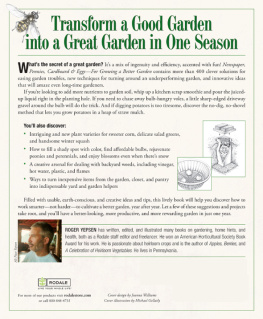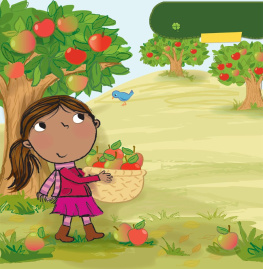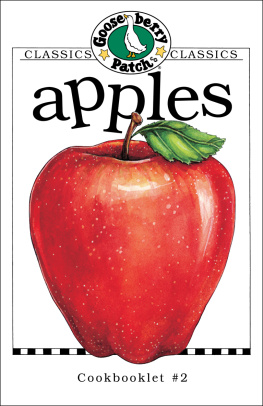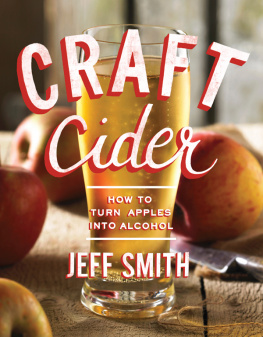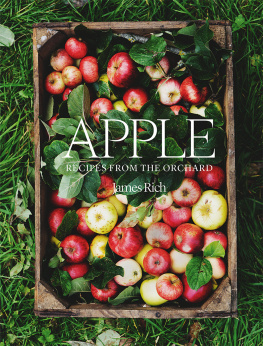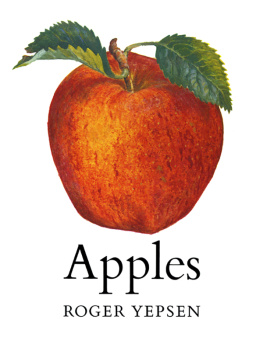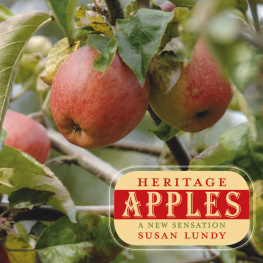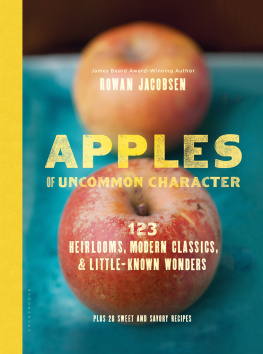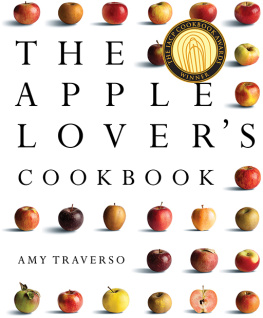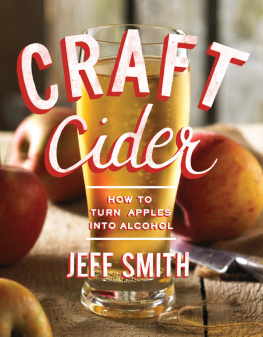Yepsen - Apples
Here you can read online Yepsen - Apples full text of the book (entire story) in english for free. Download pdf and epub, get meaning, cover and reviews about this ebook. City: New York;NY, year: 2017, publisher: Countryman Press, genre: Home and family. Description of the work, (preface) as well as reviews are available. Best literature library LitArk.com created for fans of good reading and offers a wide selection of genres:
Romance novel
Science fiction
Adventure
Detective
Science
History
Home and family
Prose
Art
Politics
Computer
Non-fiction
Religion
Business
Children
Humor
Choose a favorite category and find really read worthwhile books. Enjoy immersion in the world of imagination, feel the emotions of the characters or learn something new for yourself, make an fascinating discovery.

- Book:Apples
- Author:
- Publisher:Countryman Press
- Genre:
- Year:2017
- City:New York;NY
- Rating:3 / 5
- Favourites:Add to favourites
- Your mark:
- 60
- 1
- 2
- 3
- 4
- 5
Apples: summary, description and annotation
We offer to read an annotation, description, summary or preface (depends on what the author of the book "Apples" wrote himself). If you haven't found the necessary information about the book — write in the comments, we will try to find it.
Yepsen: author's other books
Who wrote Apples? Find out the surname, the name of the author of the book and a list of all author's works by series.
Apples — read online for free the complete book (whole text) full work
Below is the text of the book, divided by pages. System saving the place of the last page read, allows you to conveniently read the book "Apples" online for free, without having to search again every time where you left off. Put a bookmark, and you can go to the page where you finished reading at any time.
Font size:
Interval:
Bookmark:

To my uncle Rhodes Copithorn,
who was inspired by the great old Northern Spies
in his Long Island backyard
to look for an orchard of his own;
to my grandfather Defoe Mosher,
who grew Jonathans, Winesaps, Northern Spies, Rhode Island
Greenings, and Grimes Golden on his Indiana farm;
to my great-grandmother Edna Bloom Carter,
who made pies from the two unpruned Yellow Transparents
behind her house;
and to my former bandmate Thomas Knight Peper,
who got me started making hard cider and,
on frigid nights at his Pennsylvania farm, applejack.

Apples. Red, round, crisp, and cool.
The list of adjectives doesnt have to stop there. The orchards of North America have produced some sixteen thousand varieties worthy of being named. Each has its characteristic hues, heft in the hand, flavors, aromas, crispnessall of which could be called the apples personality. Some apples seem mysterious and take time to get to know. Others can be as accessible as a carrot.
There are fruity apples tasting of banana, mango, pineapple, and pear, and spicy apples tasting of licorice, cinnamon, coriander, rue, and nutmeg. Apples can be had candy sweet or lemon sour, cleanly astringent or mild-mannered, and hard as a raw potato or messy as a peach.
The best-known varieties tend to be quite apple-like: round and smooth and with at least a red blush. But others are shaped like toy tops or lopsided old pillows and have skins that may look scarred to the unaccustomed eye. A few, such as the homely Knobbed Russet, dont look like apples at all. Sizes vary from the crabs, just an inch across, to branch-bending giants the size of a babys head and weighing well over a pound.
Colors range from near white to humdrum beige to the deep, waxy near-black of a limo. And of course there are the reds in uncountable shades, patterns, and levels of opacity and luminosity. An apples red coat overlays a layer of yellow or ocher or green that will either set the apple ablaze or mute it. A Staymans red is transposed to a minor key by the green pigment below. But on a Winter Banana or Ozark Gold, the red blush acts like a lens, incandescing with the light that reflects up through it.
Until the 1800s, most orchards were casual groves of trees grown from seed. Because an apple seed doesnt produce a replica of the parent, but only a rough facsimile, these orchards were full of individuals, each one distinct. Johnny Appleseed became a fixture of American folklore by offering apple seeds to anyone willing to stick them in the ground, but this genetic crapshoot likely produced few worthy trees. In time, only the very best of Americas apple trees were given names and propagated by graftingthe horticultural handicraft by which a bit of tree branch, called a scion, is spliced into a rooted tree. The scion will take sustenance from the tree, but grow true to the tree from which it was taken. This is the only way that varieties are perpetuated over the centuries. (Henry David Thoreau, the village contrarian of Concord, Massachusetts, lamented how grafting had changed the New England landscape, saying that he didnt care for the rigid rank and file of look-alike trees.)
America was on its way to becoming a land of apple lovers. The favorite varieties of our colonial heroes have become often-repeated details of their biographies. George Washingtons most famous horticultural exploit was leveling a cherry tree, but as an adult he built a distillery for making apple brandy and was a fan of Newtown Pippins. Benjamin Franklin liked this apple so much that he had barrels of them shipped to England while lobbying there on behalf of the colonies. Perhaps the bit of trivia most associated with John Adams is that he is said to have begun each day with a tankard of hard cider. Thomas Jefferson identified Esopus Spitzenburg as his pick of the varieties grown in the hilly orchards of Monticello.
Sharp-eyed wanderers of fields and fencerows were alert to any stray tree that might be something special. Most of our better-known traditional varieties are such love children, the products of chance pollination between unknown parents. Each has its special talents: flavor, aroma, picking time, storability, resistance to disease. There were famous cider apples, baking apples, sauce apples, drying apples, and dessert apples.
Families would stock a succession of seasonal favorites from summer through late fall, when the long-keeping winter apples carried them through spring. One British visitor to the young United States marveled that apples were available eleven months of the year. And apples could be consumed year-round as hard cider, Americas most popular drink among rich and poor, young and old; apple butter; dried apples, known in Pennsylvania Dutch country as schnitz; and such all-but-forgotten items as boiled cider and cider jelly.
At rural kitchen tables, apple pies and tarts were served as routinely as bread. For families on hardscrabble farms in the Northeast, suppers through the winter might consist of nothing but apple pie and milk, day after day. For those with means, the better city restaurants served dessert apples in little individual boxes, stem and two leaves attached, with a card noting variety and grower. (Clearly, the foodie phenomenon is nothing new.) Apples were so much a part of the public consciousness that people came to be described in pomological terms: crabs, bad apples, apple polishers, apples of ones eye. To describe the narrow, ingrown persona of small-town Americans, novelist Sherwood Anderson came up with twisted apples.
Writer and illustrator Eric Sloane enjoyed tramping around rural New England, and he came to see how central apples once were to making a life in a climate that could be forbidding. In his book A Reverence for Wood, he wrote, Whenever you walk in the forest and you come upon an apple tree, stop and look about. Very likely you will see several others, too. And perhaps some ancient, stunted lilac bushes. Nearby there probably will be the ruins of an ancient house foundation, a cellar where apples were once stored, kept throughout the winter, fresh for the table before the heat of summer.
Along a remote stretch of the long-abandoned Lehigh Canal in eastern Pennsylvania there grows an apple tree by the cellar hole of what had been a lock tenders home. Well over a hundred years old, it continues to put out a few blossoms for the bees and a few apples for browsing deer. Its particular gifts, and potential promise, await someone with a pocketknife and a knack for grafting.
Of those sixteen thousand apples that once grew on this continent, only an estimated three thousand are still around. Of these survivors, some 81 percent have been classified as endangered, meaning that fewer than four nurseries continue to make the trees available to growers. And another 13 percent are said to be threatened, with between four and six nurseries handling them. These rarities include such charming oddballs as Bascombes Mystery, Stump of the World, and Horneburger Pancake (one slice, it was said, fills a pan).
How is it that weve squandered so much of that genetic wealth? One answer can be seen in our own backyards. While the home plot once produced a good deal of food for the family tablevegetable gardens, berry bushes, fruit trees, and perhaps a chicken shed or twoour principle crop today is lawn grass, with an unwelcome harvest of leaves to be raked each autumn. People began buying apples rather than going through the trouble of growing them, once refrigeration made it possible to ship apples long distances. With the advent of the supermarket, produce managers tended to stock only a few well-known varieties, particularly those that were red and rugged, rather than deal with a gaggle of local favorites.
Next pageFont size:
Interval:
Bookmark:
Similar books «Apples»
Look at similar books to Apples. We have selected literature similar in name and meaning in the hope of providing readers with more options to find new, interesting, not yet read works.
Discussion, reviews of the book Apples and just readers' own opinions. Leave your comments, write what you think about the work, its meaning or the main characters. Specify what exactly you liked and what you didn't like, and why you think so.

